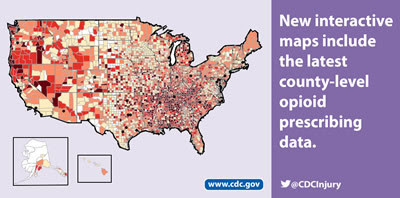New Maps: Opioid prescribing rates by state and county, 2006-2016
CDC has launched new online maps that show annual opioid prescribing rates from 2006 to 2016, both by state and by county. The maps are interactive, equipped with the ability to zoom in and out and hover over a county/state for the prescribing rate. Overall, opioid prescribing rate increased until 2012 and then has declined from 2012 to 2016. In fact, in 2016, the national prescribing rate had fallen to the lowest it had been in more than 10 years.
However, despite the decline, prescribing rates remained very high in several areas across the country in 2016. For example, while the overall opioid prescribing rate in 2016 was 66.5 prescriptions per 100 people, some counties had rates that were seven times higher than that. In about a quarter of U.S. counties, there were enough opioid prescriptions for every person to have one. Opioid prescribing rates vary widely across different states and counties, and emerging hotspot areas can be identified by the darker colors on the maps.
This new resource includes data not previously reported elsewhere. To see all national, state, and county opioid prescribing data in one location, visit our U.S. Prescribing Rate Maps.
More Information:
- CDC Drug Overdose Homepage
- CDC Guideline for Prescribing Opioids for Chronic Pain
- July 2017 CDC Vital Signs: Opioid Prescribing
New Training: Treating Chronic Pain Without Opioids
Today, CDC launches the second in a series of interactive, online trainings for healthcare providers. These trainings feature the recommendations in the CDC Guideline for Prescribing Opioids for Chronic Pain, providing sample scenarios, feedback, and resources. After completing the new module, called Treating Chronic Pain Without Opioids, participants will be able to:
- Describe risks and benefits of first-line treatments to chronic pain
- Identify preferred nonopioid medications and nonpharmacologic treatments for treating different types of chronic pain
- Describe communication techniques that facilitate a patient-centered approach to manage chronic pain
This and all future trainings will be available for continuing education credit and can be found on our Online Training page.
More Information:
- CDC Guideline for Prescribing Opioids for Chronic Pain
- Guideline Resources for Healthcare Providers
- Online Training Series for Providers: Applying CDC’s Guideline for Prescribing Opioids
- CDC July 2017 Vital Signs: Opioid Prescribing
August Webinars from the HHS Partnership Center
Join The HHS Partnership Center and experts from the CDC and the Substance Abuse and Mental Health Services Administration (SAMHSA) for a two–part webinar series designed for faith and community leaders and their community members on the opioid addiction crisis.
Understanding the Opioid Crisis: What’s at the Heart of the Matter?Wednesday, August 9, 2017, Noon - 1 pm EST.
National attention is focused on the opioid crisis, and communities are struggling to respond. In this webinar experts will share data and the science about opioid addiction, and dispel some common misconceptions about treatment and recovery. Participants will have an opportunity to ask questions and will receive information about additional resources. Register for this webinar.
There is Hope: Treatment, Recovery, & PreventionWednesday, August 16, 2017, Noon - 1 pm EST.
Connecting people to treatment and recovery support has shown to be effective and can save lives. This second webinar of the two-part series will address early intervention and treatment, and the essential role the community plays in recovery support and prevention. Experts will also discuss the impact of adverse childhood experiences on the development of a substance use disorder, and how upstream preventative action can restore hope and a brighter and healthier future to generations to come. Register for this webinar.
























.png)









No hay comentarios:
Publicar un comentario